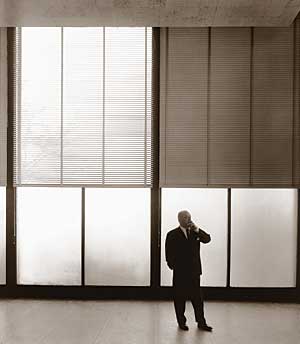The Perils of Restoring
Learning Objectives:
- Describe the challenges of restoring a Modernist building.
- Discuss the material substitutions made to Mies's design concept in order to preserve the design aesthetic.
- Explain the problems with the original glass used in the building.
Credits:
Formal ceremonies celebrating architecture are usually reserved for ground breakings, openings, or reopenings, rarely for closings. But on May 17, 2005, S.R. Crown Hall at the Illinois Institute of Technology (IIT), designed by Ludwig Mies van der Rohe and completed in 1956, was closed for restoration and renovation amid much fanfare. A hundred or so admirers of the school and the architect convened to witness a symbolic demolition-the inverse of a ribbon cutting-to launch the restoration. Mies's grandson, Chicago architect Dirk Lohan, won the opportunity to smash one of the 10-foot-tall windows at an online auction on eBay, sponsored by the Mies van der Rohe Society (mies.iit.edu).
In the audience at the ceremony was Mark Sexton, AIA, principal of Krueck & Sexton Architects, the local firm charged with this phase of an ongoing restoration of Crown Hall and other Mies structures. Sexton admits that after the sledge hammer shattered the glass and the university president announced that the reopening would take place in 15 weeks, reality set in, and his heart began to race. Although an opportunity of a lifetime for any firm, performing reconstructive surgery on what Time magazine called "one of the world's most inspiring and astonishing structures" is an undertaking fraught with danger, suggesting that a tight schedule might have been the least of Sexton's worries. Crown Hall is the home of IIT's College of Architecture, where Mies was director from 1938 until 1958. Thirty-six years after his death, the faculty still consists of Mies disciples, who, with a student body of 600, consider themselves conservators of the masterpiece, which received Chicago landmark status in 1997 and became a National Landmark in 2001.
|
The weight of "almost nothing"
Unlike earlier Crown Hall renovations in which the travertine and steel of the South Porch were replaced and women's bathrooms were added in the basement, this phase was more complex and intricate. Crown Hall contains the architectural DNA of Mies's entire aesthetic. The beauty exists paradoxically in the metaphorical nothingness of it. The building is a big box, a "one-room school house," as Dean Donna Robertson, AIA, has called it. The 120-foot-by-220-foot floor plate seems to hover 6 feet above grade. Meanwhile, the roof hangs 18 feet above the floor from an exoskeleton made of four, 6-foot-deep steel girders. From the inside, the resulting clear-span, "universal space" experience is that of being in a structure with no visible means of support. Furthermore, the curtain wall had enormous expanses of glass held in place by the slimmest of stops.










